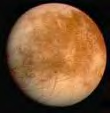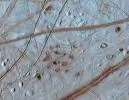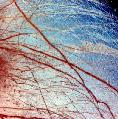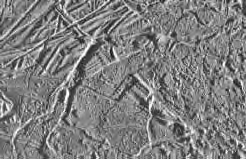
|
Radius: 1563 km |
|
Mass: 4.87 x 10'25 kg |
|
Density: 3.04 gm/cm'3 |
|
Distance from Jupiter 670, 900 km |
|
Orbital period: 3.551 days |
| On a cold clear night in 1610 Galileo Galilei made a startling discovery of moons swirling around the planet Jupiter. Of particular interest is the second largest satellite outward from Jupiter...the moon we know to be Europa. Europa is one of the brightest objects in the solar system, and the way it reflects sunlight shows that water ice is a dominant part of the surface. Europa is about the size of our moon, but has a slightly lower overall density. Such characteristics would suggest that the object is largely rocky with an ice rich outer layer. However this presents us with so many questions...How thick is the ice? Is some of the ice melted below the surface? Could there be a sub surface global ocean of liquid water? The clues as to the history and make up of Europa came in the 1970s/80s from data returned from the fly bye's of NASA's Pioneer and Voyager spacecraft. Pictures have shown us a bright orange splotchy surface with very few impact craters, suggesting geologically recent activity. Whilst there is evidence of active volcanism on Europa's neighbouring moon Io, yet given that fact that Europa is further away from Jupiter, the tidal heating is less than on Io, and therefore it was not clear as to whether there was sufficient energy present to drive active volcanoes. However the lack of impact craters would offer the view that some process had resurfaced Europa, and volcanism seemed the logical candidate. with regard to volcanism on Europa would involve water rich magmas/geysers, and if geysers were erupting then there could be enough heat to maintain a water ocean beneath the icy crust. The best evidence for liquid water beneath the crust come from high resolution images produced by the Galileo team. They show a surface that has been disrupted, leaving blocks of ice as small as a few km across that have been rafted into new positions. Many of the blocks fit back to back like a jigsaw, but with space left over...suggesting that some surface materials have been consumed, melted or that Europa has experienced global expansion. In either of the aforementioned scenarios, these crustal blocks were either floating in water or suspended in warm mobile ice or slush. A Theory of Europa – Richard Hoagland (1979) Hoagland proposed that a planet wide ocean still exists under the tens of miles thick sulphur tinged ice now completely covering the satellite. Furthermore in that extremely ancient ocean that exists, life may have once originated there because of the present uniqueness of Europa in the entire solar system..and that such life might still exist. At the time of forwarding this theory Hoagland encountered overwhelming opposition from almost everyone at NASA, except for two significant exceptions. The first was that of Arthur C. Clark, the inventor of the communications satellite and famous science fiction writer. The second, Dr Robert Jastrow, one of the founders of NASA. In the acknowledgements to his sequel to the film 2001 – A space odyssey Clark wrote 'The fascinating idea that there might be life on Europa, beneath ice covered oceans kept liquid by the same Jovian tidal force that heat Io.' NASA's Galileo mission, which set out to explore Jupiter and its satellites, finally arrived at Jupiter on December 7th 1995. The probe successfully streaked into Jupiter's crushing atmosphere that afternoon, sending back 54 minutes of invaluable data as it fell. Meanwhile the Orbiter successfully fired its own retro rockets – becoming the second man made object to be forever captured by the planet Jupiter. If the result from such a mission turns out to be positive, then future missions may look towards sending some form of robotic submarine to melt through the ice and explore the sea below. |
![]() Copyright(C) 2007
- 2020 All rights reserved.
Copyright(C) 2007
- 2020 All rights reserved.



